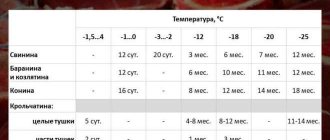Without knowing how long fried fish can be stored in the refrigerator, it is easy to get food poisoning. This is due to the fact that in the early stages of decomposition the product looks and smells like fresh, but the amount of toxins in it is no longer safe for the human body. The general rules are as follows: cooked fish can be stored in the main compartment of the refrigerator for up to 3 days, in the freezer for up to 3 months.
How to store fried fish in the refrigerator?
Depending on the desired shelf life, fried fish is placed either in the refrigerator or in the freezer.
The selected device must provide the following temperature regime:
- from +2 to +6°C – the freshness of the product is maintained for 36 hours;
- from -18 to -24°C – within seven days the loss of taste will be minimal, and the fish will remain suitable for consumption for up to three months.
It is important to take into account the fact that the temperature in household refrigerators is not always stable. Their chambers are designed in such a way that there should be free space between the shelves and the products located on them for the circulation of cold air. However, housewives often stack plates, pots, bags and trays almost side by side - this leads to an increase in temperature by 3-5 degrees, as a result of which food spoils much faster.
How long does hot smoked fish last?
If the product has been processed in the form of hot smoking, the shelf life is reduced to 3 days. Cold smoking allows you to store the product for 10 days, since this process provides longer heat treatment.
Read more ► Storing minced meat in the refrigerator and freezer
Smoked meats are stored in the freezer. This method allows you to extend the savings period up to 3 months. Can be placed in a cloth with salt and placed in cool storage. If the temperature does not exceed +3 degrees, the products will be stored for 30 days.
Smoked fish balyk can be stored for 7 days.
Attention! During the preservation process, it is important to watch for signs of mold.
Cooling
Before placing the fish in the refrigerator, it is removed from the stove and kept until it reaches room temperature. Then they are transferred to plastic or enamel containers with lids and placed on the bottom shelf. If special containers are not available, you can use a plate well wrapped in cling film or tightly folded aluminum foil.
You cannot store fish in a cast iron frying pan, even if it has been fried there. This metal reacts with foods and accelerates the oxidation of omega-3s.
Conditions and periods of storage in vacuum packaging
In production, in warehouses, during transportation, on store shelves and at home, vacuum packaging allows you to reliably protect food from dust, moisture, and dangerous microorganisms. Vacuum packaging is practical, compact, affordable and convenient; it significantly extends the shelf life and shelf life of meat, fish, fruits, vegetables, etc., and preserves their freshness and presentation. You can learn more about the benefits of vacuum packaging on our website or from our consultant by contacting him by phone.
Interesting: Freezing Green Onions for the Winter at Home
How long can vacuum-packed food last?
The shelf life of products in a vacuum environment increases significantly, on average by 3-5 times, depending on the initial quality and freshness of the products. We bring to your attention the approximate shelf life in vacuum packaging in the refrigerator for various products:
- Raw meat – 6-9 days;
- Frozen meat – 450-600 days;
- Raw fish – 4-5 days;
- Frozen fish – 300-360 days;
- Sausage – 25-40 days;
- Cheese – 30-60 days;
- Fresh vegetables and fruits – 10-20 days;
- Frozen vegetables and fruits – 540-720 days;
- Cereals, flour, coffee, tea, pasta – 360 days.
Shelf life and storage without vacuum packaging are respectively 3-5 times shorter. If you need industrial equipment or a home vacuum packaging machine, then you should definitely contact us.
Freezing
At catering establishments, food is frozen using the shock method, which cannot be done at home. For this reason, fried fish should first be cooled to room temperature, then placed in a regular refrigerator for an hour or two, and only then put in the freezer. This method will ensure uniform freezing of each piece and better preservation of taste.
We recommend: Do you need to keep receipts for utility bills if you pay online:?
It is advisable to freeze fish by placing it in special bags in one layer. After it has completely frozen, in order to save space, it can be folded into a container more tightly.
Do not leave the product in the freezer in an open container or untied bag, as this leads to “frost burn” - a rapid loss of moisture, as a result of which the fish becomes tasteless and unattractive in appearance.
Optimal storage conditions
Freshly cooked seafood in a frying pan has a lot of useful substances and microelements. In order to preserve the quality of food as much as possible, they adhere to the rules for storing it. Violation of the conditions can lead to negative consequences: loss of taste of the product, food poisoning.
After cooking, uneaten food is cooled, packaged and stored in a cool place. There are two storage options. In the refrigerator compartment. Cool the fried food on the shelf to a temperature of +2...+6. Compliance with the temperature regime is important, otherwise the thermally treated product will spoil.
Important! Some housewives pack refrigerated shelves to the top, leaving no free space for air ventilation. This feature increases the temperature in the chamber by 2-3, so storage conditions are violated. It is advisable to leave space for free passage of air to the products.
Before putting the fried dish in the refrigerator, first cool it to room temperature. Freshly prepared food should not be kept at this temperature for more than 12 hours. In the freezer. Heat-treated fish can be stored for up to 15 days at a temperature of -8...-24. Fried seafood is cooled to room temperature and placed in the refrigerator for 1-2 hours before freezing. This event allows each part to freeze evenly, better preserving the taste. To prevent fish in the freezer from getting “frost burn”, it is not left in an open storage chamber.
See also
How and where it is better to store medicines at home, interesting ideas and rules
Packing fish before storage
For long-term storage of fried fish, not only the temperature in the refrigerator is important, but also the packaging, since it performs several functions at once:
- Localization of odor. If you put the dish on a plate and put it on the shelf in this form, the rest of the food will be saturated with a specific fishy aroma. Butter, cheese, fruits and eggs are especially susceptible to this effect.
- Protection against microorganisms. No matter how clean the refrigerator may seem, colonies of pathogenic bacteria and mold fungi still live in it. And fatty protein foods are an ideal substrate for their reproduction, so fish stored in open containers becomes hazardous to health much faster.
- Moisture retention. The longer food sits in the refrigerator, the more liquid it evaporates. Consequently, the attractive appearance and taste are lost.
- Preventing foreign objects from entering the product. Insects from poorly washed greens or pieces of other food (for example, cake crumbs) can get into the dishes where the fish is, causing it to become infected or spoil prematurely.
The ideal container for fried fish is vacuum bags, in which it does not dry out even after a long period of storage in the freezer. In addition, in an airless space, the fat oxidation reaction occurs very slowly, so the product does not taste bitter.
We recommend: Common methods for storing eggplants at home
An alternative to such bags can be sealed containers. For freezing, you should choose those that can withstand sub-zero temperatures. But foil, cling film and ordinary plastic bags can only be used for short-term storage in the main chamber of the refrigerator.
Rules for storing dried and salted fish
Dried fish is prepared using large amounts of salt, which is a natural preservative. Store fish in a cool, dark, dry place for about a year. It is better to wrap it in parchment, white paper, and place it in a glass container. You should not take newspapers; topographic inks can print and be dangerous to human health.
The shelf life of salted fish (indicated in days) depends on the amount of salt and the stages of preparation:
- lightly salted salmon – 3;
- vacuum-packed fish – 30;
- herring soaked in salt solution – 14-30;
- mackerel, fatty varieties – 10;
- highly salted goods – 30;
- light salting – 7;
- pickled, medium-salted products – 14;
- workpiece, cut into pieces, filled with sunflower oil - 90.
If the taste and smell of the fish differ from fresh fish, then it is better to dispose of it. This will avoid food poisoning.
5 ideas for storing preserved food in an apartment
Warm up before use
Fish that has been stored in the refrigerator for less than 12 hours at a temperature of +2 to +6°C can be eaten cold if desired. If it spent longer there, it should be warmed up before use - fry it in oil for at least two minutes or boil it in sauce. The second method is preferable because the taste of the product is better preserved.
Frozen fried fish must be defrosted in the main compartment of the refrigerator and only then reheated. The product should not be re-frozen as this will significantly shorten the shelf life and impair the taste.
It is not recommended to use a microwave for heating: the fish will acquire a “rubbery” consistency.
It is better to keep fish in the refrigerator raw (chilled or frozen), using it for cooking as needed. But if it happens that you fried more pieces than you can eat at once, there is nothing wrong with leaving them for later, observing all storage rules and temperature conditions.
Shelf life and storage conditions of fish according to sanitary standards
SanPiN 42-123-4117-86 contains information on the rules for storing particularly perishable products, which include fish.
The maximum period for its storage in raw form does not exceed 72 hours. A temperature regime of no higher than +6 degrees must be ensured. Higher temperatures provoke the active proliferation of bacteria that cause serious food poisoning.
Isothermal transport is used to transport products. If transportation is carried out in the summer, then it is necessary to ensure that the products are kept in ice. In such conditions, transportation within 3 hours is allowed. If there is no ice, delivery to the destination is carried out within one hour.
The raw storage temperature is within +2…+6 degrees.
In rare cases, the storage period of a large batch that has arrived at the store is extended for a period of no more than 50% of the established storage period.
Summarize
Fish has a unique set of minerals, vitamins and great taste. But, being a perishable product, if storage rules are not followed, it can cause food poisoning and household problems. Therefore, you need to carefully adhere to the rules of handling it at every stage, from purchase to serving.
It is better to cook so much that there is enough for everyone to eat and there is no leftover for later. Then you can cook again. Don't put your health at risk by eating stale food.
How to tell if a dish has gone bad
There are several signs indicating damage:
- unpleasant rotten smell;
- the appearance of mold;
- coating stickiness;
- decreased elasticity of the pulp.
In such cases, it is strictly not recommended to pretend that nothing happened and serve such food on the table, or feed it to animals. The consequences can be very sad; at best, you can end up with a slight digestive disorder, and at worst, a hospital stay.
If the fish is missing, you need to come to terms with it and draw appropriate conclusions for yourself for the future. The spoiled product should be placed in a strong plastic bag, tied tightly and sent to a waste dump. You should not try to feed this to birds and stray cats, as this can greatly harm them.
How to choose fish for preparing delicious dishes
Not only the taste of the fish, but also how long it can be stored in finished form will depend on the quality and freshness of the raw materials. If it was not originally fresh, then you shouldn’t expect it to last long.
Therefore, you should pay attention to the following nuances:
- It is advisable to take fresh fish for cooking. A dish prepared from such raw materials will, after cooking, be juicier and tastier than one made from frozen.
- It is better to take medium-sized carcasses. They are quite juicy, and river fish also smell less of mud and algae.
- For all types of dishes, it is advisable to buy varieties with a minimum number of small bones. Otherwise, you will have to spend a lot of time and effort removing them. Ideally, take fillet, there is no waste and no bones.
- Fatty varieties taste better, absorb odors less and contain healthy Omega-3 and Omega-6 fatty acids, which are so necessary for humans.
- Sea and river fish are good for frying. In the first case, these are pollock, polengas, halibut, cod. Among freshwater inhabitants, carp, catfish, pike, and pike perch have proven themselves well.
It should be borne in mind that seafood contains more nutrients, has fewer bones, and can be stored longer. As practice shows, fresh fish meat contains more vitamins and minerals, has an attractive smell, and does not fall into pieces when cooked and fried.
Why you need to know how to properly store cooked fish
Proper storage of cooked fish is important primarily for humans. We are sure that there will not be a single person who wants to end up in a hospital bed immediately after tasting a fish dish. And the fish product contains a large percentage of protein, which is an excellent breeding ground for toxic microorganisms. Therefore, you need to remember that violating the procedure for handling finished fish meat can end badly. Therefore, it is necessary for everyone to be able to properly store prepared fish and pay attention to the following points
- deterioration of taste;
- the occurrence of unpleasant bitterness;
- absorption of foreign odors;
- drying out, crusting and cracking;
- damage to appearance, which reduces attractiveness.
If you notice at least one of the listed points, you need to think about it and decide to throw away the spoiled food. or do something so that the cooked fish survives until the next meal without losing its qualities.
How long can dried fish be stored?
Dried fish can also be stored for quite a long time at sub-zero temperatures. The optimal temperature for its storage is from 0 to -8°C. Under these conditions, dried fish with a high fat content is stored for two months, and with a low fat content - four months. Freezing in the freezer will extend the shelf life to five months. Also, some dried fish can be kept out of the refrigerator. When stored in dry, ventilated areas at a temperature of no more than +20°C, low-fat dried fish can be stored for up to two months.
Carcinogens or parasites. Why are dried and smoked fish dangerous? Read more
What happens to the product over time?
Over time, the fish deteriorates. Signs of spoiled fish are as follows:
- rotten smell;
- sticky scales with dents;
- gills gray or brown;
- dull eyes;
- soft, falling apart meat fibers;
- changes in the color of meat from red to gray (for salmon);
- some of the bones are separated from the pulp.
The suitability of salted, dried, dried, smoked and pickled fish can be easily determined by smell and appearance.
It is difficult to recognize the unsuitability of frozen fish; its qualities must be examined more carefully.
Note! If you place fish in water, the rotten one will float, and the fresh one will sink.
At what temperature and how long can cooked fish be stored?
Freshly prepared fish dishes are very tasty, and often, when the fish begins to cook, it seems that you can eat a lot, which means a lot is prepared, but in reality this does not always work out and the fish remains until next time. It is quite understandable to want to finish the remaining dish after a certain time, when people gather around the table again.
If the period between feasts is relatively short, you can simply leave the fish on the table, covering it with a cap. This will protect it from dust, insects, pets, and partly from pathogens. Absolutely nothing will happen to her in a few hours. Unless the crust becomes soft and the meat is better saturated.
How long can cooked pollock be stored in the refrigerator?
Pollock can be stored in
on the bottom shelf for no more than two days.
If the fish has not been cooked within 24 hours, it is better to freeze it. After two days of storage, it is not recommended to freeze pollock
; it is better to immediately use it to prepare the planned dish.
Interesting materials:
How can I find out my fines for traveling without a ticket? How to find out your speeding fines? How to find out all paid traffic fines? How to find out what the fine was for in Kazakhstan? How to find out what the traffic fine was for? How to find out what the OMVD fine is for? How to find out what a fine is for an administrative offense? How does the sanitary legislation issue a decision on imposing a fine? What is the fine for running a red light? What are the fines if you don't have a mask?
How does cooling affect product quality?
Cool the carcass with crushed ice, its mixture with salt, and cold air from a special apparatus. This allows you to slow down spoilage and preserve beneficial properties.
During cooling, a number of biochemical processes occur:
- muscle tissue density increases;
- the viscosity of the juice increases;
- weight is lost due to the evaporation of moisture from tissues;
- the development of bacteria is inhibited;
- the destruction of vitamins and microelements is delayed.
All of the above affects the meat : it becomes dry, but less dense. This also happens because part of the muscle juice leaks away during defrosting. Externally, the meat acquires a reddish-brown color, bruising and swelling, which can be noticeable even after cooking.
Reference. A product having a temperature of -1°C to -5°C in the thickness of the meat is considered chilled.
How long can you store chilled fish in the refrigerator?
On a regular refrigerated shelf, the product is stored for 2-3 hours . In a special plastic container with flake ice at a temperature from 0°C to +3°C, the chilled carcass remains fresh for 10 days.










